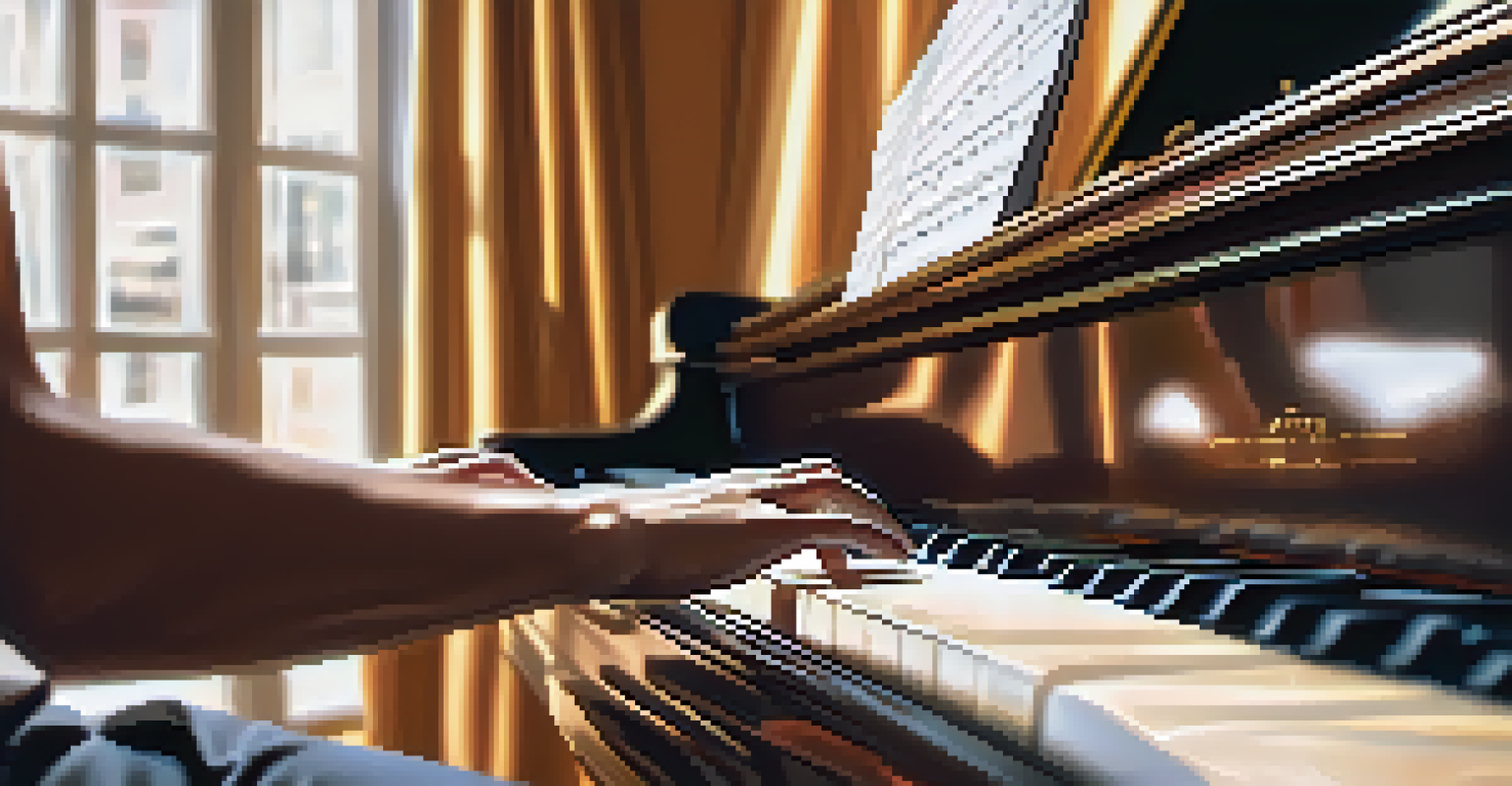How Music Scores Elevate Storytelling in Cinema

The Power of Music in Film: An Emotional Catalyst
Music has a unique ability to evoke emotions, often more than any dialogue or visual can. Think of the iconic opening score of 'Star Wars'; it immediately sets the tone and immerses the audience in the universe. This emotional pull is crucial in cinema, as it helps to create a deeper connection between the characters and the viewers.
Music can change the world because it can change people.
When a character experiences joy, sorrow, or tension, the accompanying score amplifies those feelings. For instance, in 'The Lion King', the score rises and falls with Simba’s journey, making viewers feel every triumph and loss. This emotional synergy between the visuals and the music is what transforms a film from simply being a story into an unforgettable experience.
In essence, the right music score acts as an emotional catalyst, guiding the audience through the narrative landscape. It sets the mood, enhances moments of conflict, and often lingers in our minds long after the credits roll, reminding us of the story's emotional depth.
Creating Atmosphere: Setting the Scene with Sound
A film's atmosphere is largely shaped by its music score, which can transport viewers to different times and places. Consider how the haunting melodies in a horror film can create a sense of dread, while upbeat tunes in a romantic comedy can spark joy and excitement. The score works hand-in-hand with visuals to craft a world that feels immersive and real.

For example, in 'Inception', Hans Zimmer uses deep, resonating sounds to build a tense atmosphere that mirrors the film's complex layers of dreams. This creates an overwhelming sense of urgency, drawing the audience into the characters' struggles. The atmospheric power of music essentially becomes a character in its own right, guiding the viewer's emotional journey.
Music Evokes Deep Emotions
The right music score enhances emotional connections, making viewers feel the characters' joy, sorrow, and tension.
Thus, the music score is not just background noise; it is an integral part of the storytelling process, helping to establish the setting and mood. By weaving sound into the tapestry of the narrative, filmmakers can create a more engaging and memorable cinematic experience.
Character Themes: Personalizing the Musical Narrative
Character themes are a clever technique used in film scores to reflect a character's personality or journey. When you hear a certain melody associated with a character, it can invoke their essence, much like a signature. For instance, the theme for Harry Potter is instantly recognizable and evokes feelings of wonder and courage, paralleling Harry’s own growth throughout the series.
The music is the film, and the film is the music.
These musical motifs can tell us a lot without a single word being spoken. When a character's theme plays, it can signify their presence, highlight their emotional state, or signal a transformation. This technique was brilliantly executed in 'The Godfather', where the haunting theme underscores the family's complex dynamics and moral dilemmas.
By personalizing the score with character themes, filmmakers deepen the audience's connection to the characters. This musical identification not only enriches the narrative but also allows viewers to engage with the story on a more intimate level.
Building Tension: The Art of Musical Suspense
Suspense is a crucial element in storytelling, and music plays a pivotal role in building it. A well-crafted score can heighten tension and keep viewers on the edge of their seats, making them feel every moment of uncertainty. Take the famous shower scene in 'Psycho'—the shrill strings create a sense of impending doom that grips the audience.
The use of dissonance and tempo changes in a score can manipulate the audience's emotions, creating a powerful sense of anxiety. As tension builds, so does the music, often culminating in a climax that leaves viewers breathless. This technique keeps audiences engaged and invested in the outcome of the story.
Atmosphere Shapes Storytelling
Music is integral to creating a film's atmosphere, immersing viewers in different settings and emotional contexts.
Thus, the art of musical suspense is not merely about sound; it’s about the emotional journey it takes the viewer on. The score becomes a psychological tool that draws the audience into the heart of the narrative, amplifying their anticipation and fear.
Cultural Context: Music as a Storytelling Device
Music often reflects the cultural context of a film, enriching the storytelling experience. By incorporating traditional instruments or styles, filmmakers can transport audiences to a specific time or place. For instance, the use of Indian classical music in 'Slumdog Millionaire' not only sets the backdrop but also gives insight into the characters and their environment.
This cultural layering through music can enhance the authenticity of the narrative. In films like 'Coco', the vibrant Mexican melodies not only celebrate the culture but also serve as a narrative device, connecting the characters to their heritage and family history. Music here becomes a bridge between the past and present, further deepening the story's impact.
In essence, when music is woven into the cultural fabric of a film, it adds another dimension to the storytelling. It helps audiences understand and feel the nuances of different cultures, making the narrative richer and more relatable.
Foreshadowing and Resolution: Using Music to Hint Events
Music can serve as a powerful tool for foreshadowing events in a film, subtly hinting at what’s to come. Composers often use specific motifs or changes in the score to signal an impending twist or reveal. For example, in 'Jaws', the iconic two-note theme creates a sense of dread that foreshadows the shark's presence, even before it appears on screen.
This technique not only builds anticipation but also enriches the narrative by providing clues that attentive viewers can pick up on. As the story unfolds, the music can shift to reflect changes in the plot, guiding the audience's emotional response and understanding. This dual layer of storytelling enhances the overall cinematic experience.
Themes Personalize Character Journeys
Character themes in film scores provide a deeper connection to the characters, enriching the narrative without words.
Moreover, music can also play a role in resolution, bringing closure to character arcs and themes. A well-composed score can evoke a sense of finality and satisfaction, tying up loose ends and leaving the audience with a lasting impression of the story.
The Lasting Impact: Music's Role in Film Legacy
The impact of a film's music score often extends far beyond the credits. Iconic scores become part of popular culture, influencing everything from other films to personal playlists. Think of how the theme from 'Titanic' continues to resonate, evoking powerful emotions even years later. It’s a reminder of how music can transcend the screen.
Scores also enhance the memorability of a film, making certain scenes unforgettable. When we hear a familiar score, it can instantly transport us back to the emotions we felt while watching the film. This lasting connection is a testament to the power of music in cinema, proving that a great score can elevate a film's legacy.

In conclusion, music scores are not just an accessory to films; they are essential elements that shape storytelling. Through emotional resonance, cultural context, and memorable motifs, music has the power to create a lasting impact, ensuring that both the film and its score remain cherished in the hearts of audiences.